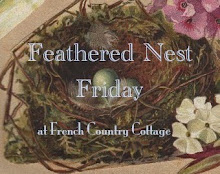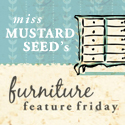When I thought about showing you a design in progress this was my choice. That was good (am getting it painted) and then some bad (the surface sucked up the acrylics making it a pain).
(click the photo to go to the bench post if you wish)

I have done a post on Supplies. Lesson 1
I have posted on some basic Strokes. Lesson 2
Now lets see some in practice.
Many times I will lay out a design on a piece of paper but at other times I just start and go with what comes to mind or what I feel like painting.
An option is to lay down some background color, I do not always but it can create some depth or dimension.
You can put pounce on some color like this (I used a mix of white, grey with a very tiny touch of light green)
It is only slightly darker than the background.
Before this I had pounced on the colors and did not like it, it was too dark with too much green so I took a damp paint rag (I use my husbands old white t-shirts, perfect for wiping brushes on and fixing your mistakes)and wiped the paint off. Even the partially dried paint came off.
The most useful skill you will learn is different ways of correcting what you don’t like. Taking a damp rag and wiping off paint is just one of them.
After I have pounced on an acceptable background I make white circles with my brush as placement of my roses. You can see them in the video below but I also included a photo of my yellow roses post.
Of course, the circles are yellow in the photo. (if you wish to see the entire post just click the photo)

I base paint the leaves the lighter of the two colors I use when stroking them in. This will make them more opaque.
I place the leaves first so the roses will look to sit atop them. The video gives you an idea of how I stroke the undercoat and that I am not that neat about it.
Next I double load my brush with the lighter green (delta Stonewedge) and the darker green (folkart Thicket).
I stroke over the base coat, I make sure I do not flip the brush as I want the dark against the light in the center. It creates the shadowing that makes it look like the veining or crease in center without having to come back in and shade it.
This next video shows one method you can do to cover over something you don’t like. You can stipple or pounce on some white, it will provide a base for fitting in different flower or design to hide what you don’t like. Or add some stems and make it a yarrow. Use your imagination.
I had more videos going on into the rose but I completely muffed them up. One was a partial of this rose being painted, somehow I caught the first two rows of strokes and the camera went off. I think the card was full. I was doing a lot of retakes.

Here it is, I downloaded to show you what I did get done and how it just cuts off.
I will be back with a good video of that. But you have the basic background now. I build in layers and left room for some filler flowers which will be in another lesson. As you can see in this photo I ended up painting a new leaf over the leaf I did not like and had pounced white on.
I just wanted to share one of my older paintings. One of my first roses, to be precise. Now this may help you if you are discouraged and think I got it down right off the bat because the proof that I did not is here.

The carnations are not to bad but the rose is rather sad. But I am so glad I kept this one sign I made to look back on. If you think that rose is bad, take a look at this iris.

See, we all start out struggling. But as I said before it is like learning to write, you struggle to make the letters look like letters and we all do manage to learn it but then we develop our own styles so your rose will not look exactly like mine. And even my roses never look exactly like each other.
I also found out that decoratively painting on a surface that has been coated in chalk paint is difficult. Most of my signs and surfaces are finished with an eggshell or satin latex. The chalk paint soaked up the moisture in the acrylics causing them to drag more. So I would suggest having your base be either of those two finishes or go over the chalk paint with a water base varathane in a matte finish before painting on your design.
It took me over an hour of struggling with getting my strokes to flow today to remember that I had painted the bench with chalk paint.
Next, is the video of the rose painting. I will keep at this videoing until I get it right!

I am considering starting an MEME so you can share your attempts with me. Just let me know if any would even share or not. It would go a long way in encouraging me to keep at this even when I spend an entire day trying to make a short decent post.
Hmmm...maybe I will just post a Linky tool and go for it. We shall see if any will play.



















Thank you so much for this lesson!!! How generous of you to share!!! I have been practicing for years and still can't master this technique, but will give it another go this winter....thank you again!!!
ReplyDeleteBeautiful, thank you for sharing the how to's with us. xo
ReplyDeleteThanks again, Pam!
ReplyDeleteWatching your videos are so soothing to me, you make it look easy. Thank you SO MUCH for taking the time to do them. Learned a few new things today~the pouncing of the background and also to cover up mistakes. I did not know this. I bet I'll be doing lots of pouncing before I get a great looking rose and leaves.
ReplyDeleteHave a great weekend!
Thank you for another great tutorial ! What is MEME?
ReplyDeleteI really, REALLY appreciate the time you are investing in all of us :-)
Pam, I hate to think, with all the things that you do, that you spend a whole day making a video for us, but if you knew how much I, for one, look forward to them, and how much I practice, you'd at least know it's not entirely wasted. I have lots of books, and I even took a subscription to some magazine, which didn't help much, but doing this along with you keeps me going. Maybe it's knowing that others are putting in the effort at the same time. I'd be happy to post my pages and pages of practice. Not that they are worth looking at, but at least you'd know your students are doing their homework.
ReplyDeleteI don't have the knack yet of the larger leaf, the pretty one, so I'm going back to do more of that now. Also to practice some of that rose, though I don't have much hope for it.
Can you please make Lesson 4 some strokes to practice, and to put together in some way? I'm a bit clueless, and I need some direction. I know it looks obvious to you, but it's really very complicated from where I sit. I need some simple designs to execute with skills we've practiced, maybe something I can put on the refrigerator with a magnet.